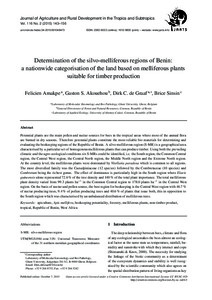Aufsatz

Determination of the silvo-melliferous regions of Benin: a nationwide categorisation of the land based on melliferous plants suitable for timber production
Zusammenfassung
Perennial plants are the main pollen and nectar sources for bees in the tropical areas where most of the annual flora are burned in dry seasons. Therefore perennial plants constitute the most reliable bio materials for determining and evaluating the beekeeping regions of the Republic of Benin. A silvo-melliferous region (S-MR) is a geographical area characterised by a particular set of homogenous melliferous plants that can produce timber. Using both the prevailing climatic and the agro-ecological conditions six S-MRs could be identified, i.e. the South region, the Common Central region, the Central West region, the Central North region, the Middle North region and the Extreme North region. At the country level, the melliferous plants were dominated by Vitellaria paradoxa which is common to all regions. The most diversified family was the Caesalpiniaceae (12 species) followed by the Combretaceae (10 species) and Combretum being the richest genus. The effect of dominance is particularly high in the South region where Elaeis guineensis alone represented 72.6% of the tree density and 140% of the total plant importance. The total melliferous plant density varied from 99.3 plants ha^(−1) in the Common Central region to 178.0 plants ha^(−1) in the Central West region. On the basis of nectar and pollen source, the best region for beekeeping is the CentralWest region with 46.7% of nectar producing trees, 9.4% of pollen producing trees and 40.6% of plants that issue both, this in opposition to the South region which was characterised by an unbalanced distribution of melliferous trees.
Zitierform
In: Journal of Agriculture and Rural Development in the Tropics and Subtropics. Kassel : Kassel University Press. - Vol. 116, No. 2 (2015), S. 143-156Sammlung(en)
Vol 116, No 2 (2015) (Journal of Agriculture and Rural Development in the Tropics and Subtropics (JARTS))Zitieren
@article{urn:nbn:de:hebis:34-2015061048473,
author={Amakpe, Felicien and Akouehou, Gaston S. and de Graaf, Dirk C. and Sinsin, Brice},
title={Determination of the silvo-melliferous regions of Benin: a nationwide categorisation of the land based on melliferous plants suitable for timber production},
year={2015}
}
0500 Oax 0501 Text $btxt$2rdacontent 0502 Computermedien $bc$2rdacarrier 1100 2015$n2015 1500 1/eng 2050 ##0##urn:nbn:de:hebis:34-2015061048473 3000 Amakpe, Felicien 3010 Akouehou, Gaston S. 3010 de Graaf, Dirk C. 3010 Sinsin, Brice 4000 Determination of the silvo-melliferous regions of Benin: a nationwide categorisation of the land based on melliferous plants suitable for timber production / Amakpe, Felicien 4030 4060 Online-Ressource 4085 ##0##=u http://nbn-resolving.de/urn:nbn:de:hebis:34-2015061048473=x R 4204 \$dAufsatz 4170 7136 ##0##urn:nbn:de:hebis:34-2015061048473
<resource xsi:schemaLocation="http://datacite.org/schema/kernel-2.2 http://schema.datacite.org/meta/kernel-2.2/metadata.xsd"> 2015-10-26T13:38:13Z 2015-10-26T13:38:13Z 2015-10-07 1612-9830 2363-6033 urn:nbn:de:hebis:34-2015061048473 http://hdl.handle.net/123456789/2015061048473 eng Kassel University Press Urheberrechtlich geschützt https://rightsstatements.org/page/InC/1.0/ apiculture Apis mellifera beekeeping potentiality forestry melliferous plants non-timber product tropical Republic of Benin West Africa 630 Determination of the silvo-melliferous regions of Benin: a nationwide categorisation of the land based on melliferous plants suitable for timber production Aufsatz Perennial plants are the main pollen and nectar sources for bees in the tropical areas where most of the annual flora are burned in dry seasons. Therefore perennial plants constitute the most reliable bio materials for determining and evaluating the beekeeping regions of the Republic of Benin. A silvo-melliferous region (S-MR) is a geographical area characterised by a particular set of homogenous melliferous plants that can produce timber. Using both the prevailing climatic and the agro-ecological conditions six S-MRs could be identified, i.e. the South region, the Common Central region, the Central West region, the Central North region, the Middle North region and the Extreme North region. At the country level, the melliferous plants were dominated by Vitellaria paradoxa which is common to all regions. The most diversified family was the Caesalpiniaceae (12 species) followed by the Combretaceae (10 species) and Combretum being the richest genus. The effect of dominance is particularly high in the South region where Elaeis guineensis alone represented 72.6% of the tree density and 140% of the total plant importance. The total melliferous plant density varied from 99.3 plants ha^(−1) in the Common Central region to 178.0 plants ha^(−1) in the Central West region. On the basis of nectar and pollen source, the best region for beekeeping is the CentralWest region with 46.7% of nectar producing trees, 9.4% of pollen producing trees and 40.6% of plants that issue both, this in opposition to the South region which was characterised by an unbalanced distribution of melliferous trees. open access In: Journal of Agriculture and Rural Development in the Tropics and Subtropics. Kassel : Kassel University Press. - Vol. 116, No. 2 (2015), S. 143-156 Amakpe, Felicien Akouehou, Gaston S. de Graaf, Dirk C. Sinsin, Brice Gedruckte Ausg. im Verlag Kassel Univ. Press (www.upress.uni-kassel.de) erschienen. </resource>
Die folgenden Lizenzbestimmungen sind mit dieser Ressource verbunden:
Urheberrechtlich geschützt

